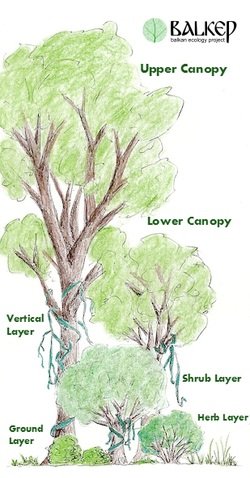Plants for Seven Layers of a Forest Garden

Visit http://www.balkep.org/forest-garden-plants.html for profiles of 100's of species
The Upper Canopy includes both pioneer and slow-growth species. The fast-growing, nitrogen-fixing, pioneer species quickly dominate the upper canopy while providing soil fertility, water retention, wildlife habitat, and eventually timber. The slow-growth species include a variety of late-succession nut and timber trees.
The Lower Canopy includes fruit trees, nitrogen fixers and nectary species ideal for bee-keeping. Many of these species are also long-term timber resources and provide excellent wildlife habitat.
The Vertical Layer includes many food-bearing species. However in a temperate climate some of these vigorous climbing plants can negatively impact the growth and yield of other species. Care should be taken when designing the vertical layer of your garden.
The Shrub Layer features shade-tolerant species with edible berries and fruits. Some of these plants also provide a valuable source of biomass, nitrogen fixation and habitat for wildlife.
The Herb Layer is most abundant in the early stages of succession. They provide many edible and medicinal resources for humans, while providing rich habitat for pollinators and pest predators.
The Ground Cover species protect the soil from erosion and reduce the need for mulch as a forest garden develops. Many of these plants provide edible and medicinal resources.
The Underground Layer provides an excellent source of nutritious, winter foods. Many of these plants penetrate the subsoil in search of minerals, nutrients, and water which enriches the soil for plants with less vigorous rooting systems.
Visit http://www.balkep.org/forest-garden-plants.html for profiles of 100's of species

This is a game-changer.